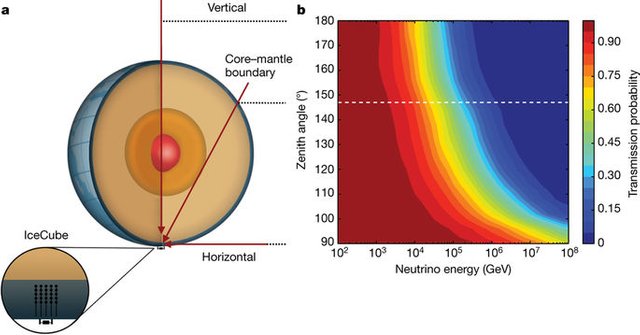Neutrinos: The Earth swallows them!
First measurement of the absorption of high-energy neutrinos confirms the standard model
Neutrinos can not pass matter unhindered: For the first time, measurements of the IceCube detector prove that part of these "ghost particles" are absorbed by the Earth. The higher the energy of the neutrinos, the less of them make the passage through our planet, as the physicists report in the journal "Nature". This behavior corresponds to what the standard model of physics predicts for these particles - and contradicts speculation about new physics.

For the first time the IceCube detector in the Antarctic has proven that neutrinos with very high energies are partially absorbed by the Earth. © IceCube CollaborationNeutrinos are considered "ghost particles" because these elementary particles have almost no mass and only very rarely interact with other matter. Every second, 100 trillion neutrinos rush through our bodies without feeling it. They are formed, among other things, in the sun, in the radioactive decay of elements, but also in cosmic events such as supernovae or gamma-ray bursts.
More collisions at higher energy?
But according to theory, even neutrinos do not come through completely without contact with the matter: the physical standard model says that the higher the energy of a neutrino, the number of collisions with atoms and therefore the absorption rate increases. In the lower energy range, the probability of collision increases is almost linear. In the case of high-energy neutrinos, however, the curve flattens slightly, according to theory.
Whether this is true, however, was previously experimentally proven only for low energies up to about 370 gigaelectronvolt. Because the particle accelerator is not capable of further performance . Whether high-energy neutrinos follow the standard model, or whether perhaps even previously unknown physical processes take effect, remained unclear.
Flight through the Earth
For the first time, data from the IceCube detector in the Antarctic provide information about this "terra incognita" of neutrino research. The detector consists of 5,160 basketball-sized sensors recessed on long cables in the Antarctic ice. Together they form a detector field of about one cubic kilometer, which records the so-called Cherenkov radiation - the tiny flashes of light that occur when a neutrino collides with an atom.
The trick here: The neutrinos not only race from above or from the side through the ice, some of them come from below. They hit the detector after crossing the Earth. In addition, IceCube can detect extremely high-energy neutrinos. In order to determine if and how many of these high-energy neutrinos will "hang" as they fly through the Earth, the researchers evaluated 10,784 up-stream neutrino signals at energies of 6.3 to 980 teraelectronvolt.
Absorbed through collisions
The result:
Our results show that neutrinos with very high energy can be absorbed by something - in this case from Earth, says Doug Cowen of Pennsylvania State University. This is something that has never been experimentally proven before.
According to the data, significantly less high-energy neutrinos were fed into the detector from below than from the side or from above. The longer the path of these particles through solid matter, the more of them were absorbed.
Neutrinos have the well-deserved reputation of always being good for a surprise, says IceCube spokesman Darren Grant. It is therefore incredibly exciting to experience this first measurement.

The comparison of laterally and from below through the Earth arriving neutrinos reveals the absorption rate. © IceCube CollaborationStandard model confirmed
As the researchers report, the absorption rate approximates what the standard physical model predicts: there was a rather slow increase in collisions with increasing neutrino energy.
A dramatic increase, as some theories of new physics beyond the standard model postulate, was not observed, according to the scientists.
For many physicists, who had hoped for hints on extra dimensions or exotic particles, the current result is therefore rather a disappointment.
Of course, we were hoping that evidence for a new physics would emerge, says Francis Halzen of the University of Wisconsin-Madison. But as usual, the standard model has passed this test.
Measuring principle and results explained by IceCube researchers © IceCube Neutrino ObservatoryHowever, a new physics is not completely excluded: it could hide itself in the neutrinos with the highest energies. These particles move in the range of more than one petaelectronvolt and are only extremely rarely captured by the detectors. In order to investigate their behavior, the IceCube researchers now want to evaluate data from several years and all 86 detector strands of their plant and thereby specifically search for these neutrinos.
Source: Nature, 2017; doi: 10.1038

does its things to be worry about.. it's mean for human will be less nutrition .. it's seems harmfull
helpful information thanks for share.
nice post@n3bul4
helpful information... nowdays human are effected by many ways also can see many disease it's all created by human it's self
Congratulations! This post has been upvoted from the communal account, @minnowsupport, by n3bul4 from the Minnow Support Project. It's a witness project run by aggroed, ausbitbank, teamsteem, theprophet0, someguy123, neoxian, followbtcnews/crimsonclad, and netuoso. The goal is to help Steemit grow by supporting Minnows and creating a social network. Please find us in the Peace, Abundance, and Liberty Network (PALnet) Discord Channel. It's a completely public and open space to all members of the Steemit community who voluntarily choose to be there.
Resteemed your article. This article was resteemed because you are part of the New Steemians project. You can learn more about it here: https://steemit.com/introduceyourself/@gaman/new-steemians-project-launch